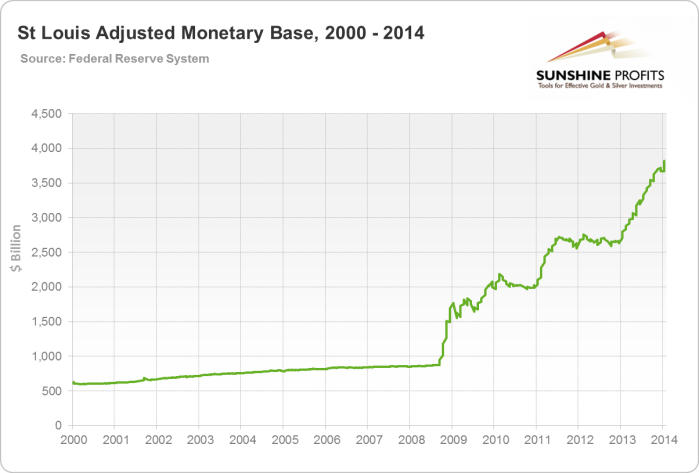Based on the Feb 2014 gold Market Overview report.
In the past years, the Federal Reserve dropped many inflationary bombs on the markets. Inflationary in the purely monetary sense by supplying money in almost ridiculous amounts, especially base money figures. During this process some commentators believed that the dollar would soon evaporate, that investors will run away in favor of the euro (like the EBC had not been printing euros for their banks), or maybe in favor of the yen (like the Japanese central bank was not that inflationary), or who knows maybe even the yuan. The dollar was supposed to be either dropped by international investors, or killed from within by internal inflationary rates (or possible by those two factors combined together). None of this happened. How are we to explain this if the Fed went almost crazy in monetary creation?
Has Fed printed all this money or not?

As the above chart suggests, a lot of “something” was created in the past years and this trend accelerated in 2008.
This nice looking green hockey stick is about base money. Base money is the money, which builds the monetary economy, but it does not complete it to its full extent. Many transactions in the economy are not conditioned by movements of this monetary aggregate. Base money consists of actual paper notes and coins, and money stored at the central bank (which actually could be changed into paper notes, since the central bank itself produces those two things). It sometimes can be called as “outside money”, meaning that it is money outside of the banking system – it is “exogenously” supplied from outside of the financial markets, and not generated by banking decisions. It is produced by political, or quasi-political means, through the tools of the central banks. This perfectly explains why so much of it could be created within the time span of five years. On a side note, the gold supply cannot be expanded at this pace (a bad feature of gold for past rulers and sufficient rationale for them to demonetize it).
We’ve already seen this green hockey stick so many times in so many places; but despite some Armageddon predictions the end of the dollar seems far away. Why is the dollar thriving if in five years there is four times more of it? Why are inflation rates not four times higher than they were at times before the crises? If the money supply is being printed at such a pace, surely it should boost the prices, shouldn’t it?
That is the usual monetarist story. Unfortunately, or maybe gladly, we should say it is not true; or more precisely not true in this case. The important fact about money printing, which has to be remembered in any analysis, is that it all depends upon how the “printing” is done, and where the money goes. As the old saying goes, follow the money, and it should lead to you answers you are searching for.
Paper notes and coins are being spent in the market for sure. Money placed at the central bank belongs to commercial banks and is not directly spent as paper notes are (sorry – individuals are not allowed to have accounts at the central bank, even on the Internet; it is a special right exclusively reserved for commercial banks). Nevertheless any bank is happy to have such money in its account at the national central bank. The graph above depicts precisely this type of adjustment that happened due to the Fed’s actions. Electronic money was “magically” produced and transmitted into the commercial banks. As you may reasonably expect, they were more than happy to accept this precious gift from the Fed. Especially in the light of the fact that “collateral” for this fresh money could be made out of junk paper related to a dying real estate market.
The point is that if one wants to be detailed, it is at least misleading to describe monetary creation as money printing. It sounds really nice, dramatic and appealing, one has to admit. Yet the truth is that this money is created not with ink and paper, but by pressing the button and producing computer zeroes in electronic books and accounts. Here is where the trick begins and here is why this tremendous electronic printing did not cause either an inflationary spike, or a run away from the dollar.
The banks are glad to accept any pile of money. Either from the government (fiscal policy), or from the central bank (by monetary policy), or also by more voluntary means, by accepting deposits, or additional equity from the investors. Yet whenever they receive this money, the profit for them is not really to just spend the money. The profit for them comes from possibility of lending this money at interest, and this is not something they absolutely have to do.
Consequently, base money creation does not necessarily have to translate into a quick plunge in the value of the US dollar, or to have massive inflationary implications. In this way, money can be created, but without immediate consequences that one would expect. In other words, in this way, the money “printing” can exist and be absent at the same time.
Thank you.
Matt Machaj, PhD
Sunshine Profits‘ Market Overview Editor

